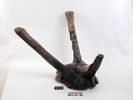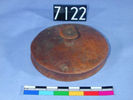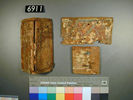| Homepage | Timeline | Maps | A-Z index | Learning |
Furniture in Egypt
The hyperarid climatic conditions of Egypt since the third millennium BC are perfect for the preservation of organic material, including furniture. Close to the river, though, damp can still destroy such material: the best chance for the survival of organic objects are items placed in a tomb on dry ground. However it was not the custom in all periods to place furniture in a tomb. This happens on a larger scale only in the Early Dynastic Period (about 3000 BC) and in the first half of the New Kingdom (about 1550-1069 BC). In the Old Kingdom (about 2686-2181 BC) and First Intermediate Period very often a cosmetic box was placed in a tomb. Furniture found at settlement sites is usually broken, but even fragments provide useful information on technology. The tomb decoration of all periods is a further source of information for furniture and carpentry. The combination of original objects and depictions in art makes it possible to gain a better picture of furniture in Egypt, than from any other ancient civilisation.
|
Furniture of the Early Dynastic Period
|
Furniture in the Old Kingdom
|
Furniture in the Middle Kingdom
|
Furniture in the New Kingdom
|
Furniture in the Late Period
|
Furniture in Roman Egypt
|
There are not many types of furniture. Objects were stored in boxes, but also very often in baskets. Chairs are an item of luxury, reserved for people in a higher position; sitting on the ground, often on mats, was more common. Beds are also luxury objects, only reserved for the richest in society. Most people slept on simple mats laid on the ground. headrests are an important category of furniture. Today most people might consider it not very comfortable to use a headrest, but this is a cultural reflex, and they might have had an important function, to protect against insects while sleeping. Most furniture was rather simple; particularly beautifully decorated pieces attract most attention today, but these should not be taken as typical.
compare Islamic wood working



